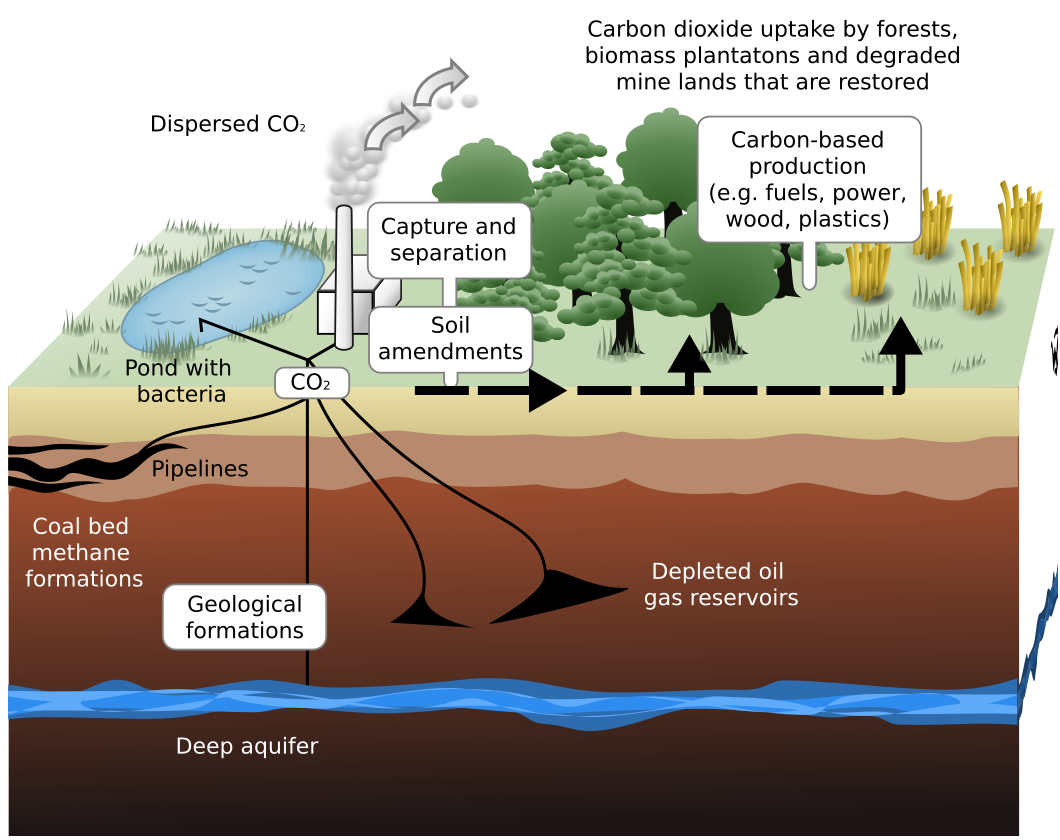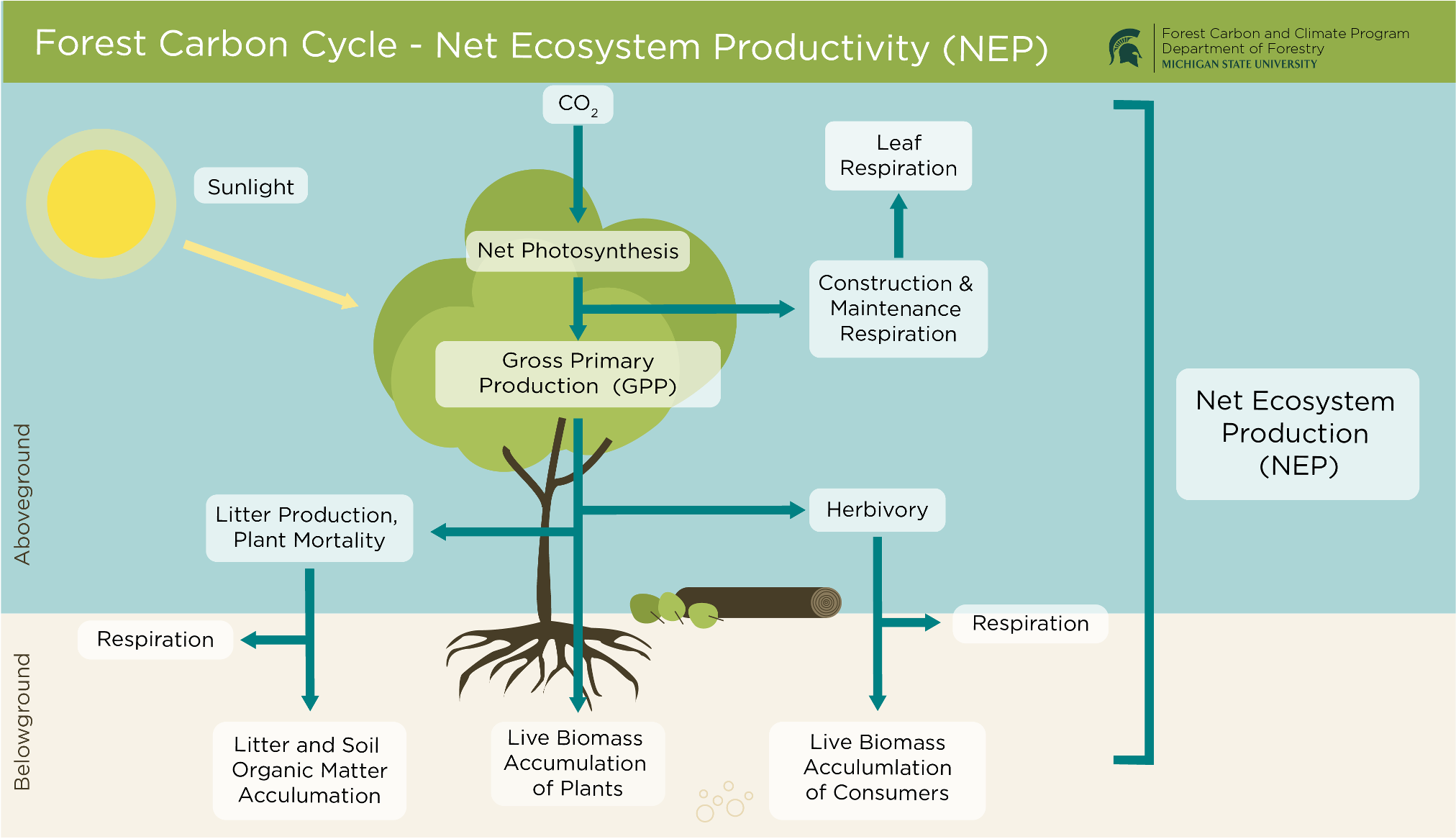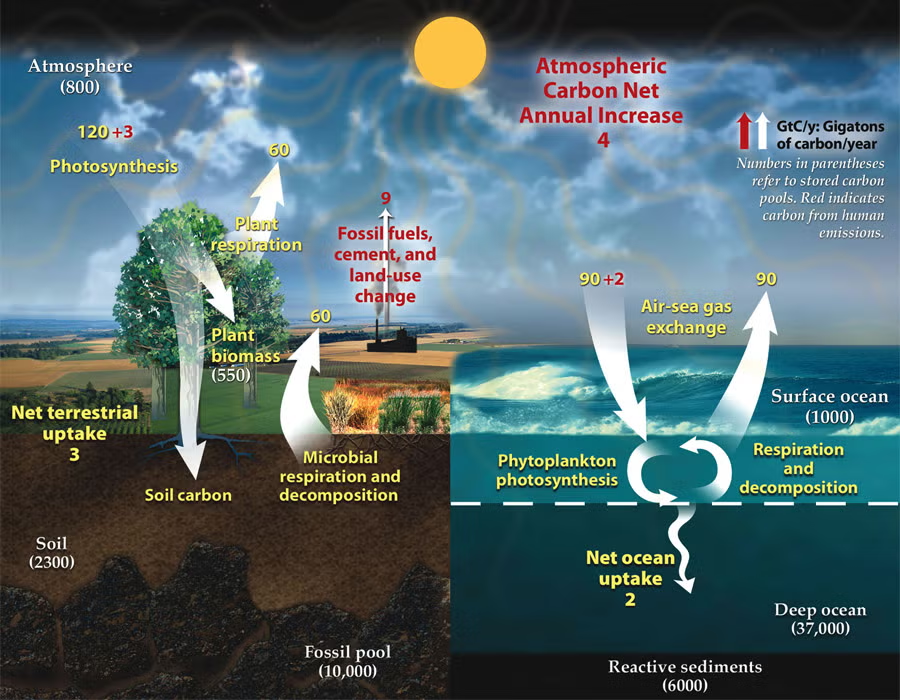IB Syllabus focus:
‘Sequestration captures CO₂ into biomass or long-lived forms. Young forests act as sinks, mature forests as stores, and disturbed forests as sources. Fossil-fuel stores become sources when burned.’
Carbon sequestration, fossil fuel use, and the balance of ecosystems are central to understanding human impact on Earth’s systems, as they directly affect climate regulation and biosphere integrity.
Carbon Sequestration
Carbon sequestration refers to the process of capturing and storing atmospheric carbon dioxide (CO₂) in either biological or geological forms. It plays a vital role in moderating global climate by reducing greenhouse gas concentrations in the atmosphere.
Carbon sequestration: The long-term capture and storage of CO₂ in biomass, soils, oceans, or geological formations, preventing its release into the atmosphere.
There are two primary pathways for sequestration:
Biological sequestration: Absorption of CO₂ by plants during photosynthesis, stored in biomass and soils.
Geological sequestration: Storage of CO₂ in underground formations such as depleted oil and gas reservoirs.

Simplified schematic contrasting terrestrial sequestration (CO₂ uptake by vegetation/soils) with geological sequestration (CO₂ captured at a power plant and injected into deep formations). Labels make the capture-transport-storage steps explicit; the mention of specific formations (e.g., saline aquifers) is extra detail beyond the syllabus but remains helpful context. Source.
Forests and Sequestration
Young forests act as carbon sinks, actively absorbing large amounts of CO₂ as trees grow and accumulate biomass.
Mature forests function more as carbon stores because the rate of carbon uptake balances with the rate of carbon release through respiration and decomposition.
Disturbed forests, such as those cleared by logging or fire, shift from sinks or stores into carbon sources, releasing large amounts of CO₂.
Fossil Fuels as Carbon Stores
Fossil fuels represent carbon stored in geological formations over millions of years, primarily as coal, oil, and natural gas.
Fossil fuels: Non-renewable energy resources formed from ancient biomass, storing carbon underground until extracted and combusted for energy.
When fossil fuels are burned, stored carbon is rapidly released into the atmosphere as CO₂, dramatically altering natural carbon balance. This process contributes significantly to the greenhouse effect and global warming.
Key points:
Fossil fuel combustion is the largest anthropogenic source of CO₂.
Once fossil fuels are extracted and used, their carbon cannot be restored within human timescales.
Reliance on fossil fuels shifts the planet’s systems from relative equilibrium towards instability.
Ecosystem Carbon Balance
An ecosystem’s balance depends on the interactions between carbon sinks, stores, and sources. Disturbances—both natural and human-induced—alter this balance.
Carbon balance: The relationship between carbon inputs and outputs within an ecosystem, determining whether it functions as a sink, store, or source.
Natural Balances
In stable ecosystems, inputs (photosynthesis, sequestration into soils) roughly equal outputs (respiration, decomposition).

Diagram of a forest carbon cycle highlighting gross primary production, component respirations, and Net Ecosystem Production (NEP), showing how carbon moves above- and below-ground. This clarifies why some ecosystems function as sinks, stores, or sources depending on the balance of inputs and outputs. Source.
Human Impacts on Balance
Human activity has pushed many ecosystems beyond their natural regulatory capacities:
Deforestation reduces sequestration capacity and turns forests into net carbon sources.
Agricultural expansion increases soil disturbance, accelerating decomposition and carbon release.
Fossil fuel combustion injects excess CO₂ into the atmosphere, overwhelming natural sinks.
Carbon Stores: Sinks, Sources, and Flows
In the global carbon cycle, sequestration, fossil fuels, and ecosystems function in interconnected roles:

A labelled carbon-cycle diagram showing the principal reservoirs (atmosphere, land, ocean) and bidirectional fluxes that link them; human-driven emissions appear explicitly. Note: numerical flux values (GtC yr⁻¹) shown exceed what the syllabus requires, but they do not add conceptual complexity. Source.
Sinks: Absorb and retain carbon for significant periods. Examples include young forests and oceans.
Stores: Hold carbon in relative stability, such as mature forests and peatlands.
Sources: Release carbon into the atmosphere, including disturbed ecosystems and burning fossil fuels.
Key Processes in Balance
Photosynthesis: Converts atmospheric CO₂ into biomass.
Respiration and decomposition: Return CO₂ to the atmosphere.
Combustion: Releases stored carbon from fossil fuels or biomass rapidly.
Sequestration: Captures and locks away carbon, either biologically or geologically.
Sequestration Strategies and Ecosystem Integrity
Protecting ecosystem balance requires enhancing sequestration processes while reducing emissions.
Afforestation and reforestation increase biological sequestration capacity.
Soil carbon management (e.g., regenerative agriculture) improves carbon storage in soils.
Wetlands and peatlands are vital long-term carbon stores; their protection prevents massive CO₂ release.
The Role of Fossil Fuels
As long as fossil fuels remain the dominant energy source:
Anthropogenic CO₂ emissions will exceed natural sequestration capacity.
Ecosystem resilience will continue to decline under stress from climate change.
The global carbon cycle will become increasingly unbalanced, risking irreversible tipping points.
Planetary Boundaries and Future Outlook
The biosphere integrity boundary is already under pressure, with carbon emissions from fossil fuels and disturbed ecosystems driving climate instability. Maintaining balance requires:
Reducing fossil fuel dependency.
Protecting and restoring natural sinks.
Developing engineered sequestration solutions, such as carbon capture and storage (CCS).
By understanding sequestration, fossil fuels, and ecosystem balance, students gain essential insight into how human activity shapes the carbon cycle and global environmental sustainability.
FAQ
Sequestration efficiency depends on species composition, soil type, climate, and disturbance history. Fast-growing species with high photosynthetic rates store carbon quickly, but long-lived species lock carbon more securely.
Soil fertility and moisture also determine storage capacity. Warm, wet conditions accelerate growth but may increase decomposition rates, reducing net storage.
Natural fluxes like respiration and photosynthesis cycle tens of gigatonnes of carbon annually, but they are largely balanced.
Fossil fuel combustion adds around 9–10 gigatonnes of carbon each year, representing an extra input that is not matched by natural sequestration, pushing the system out of equilibrium.
Peatlands accumulate partially decomposed plant matter under waterlogged, low-oxygen conditions.
Carbon remains trapped for thousands of years.
Disturbance or drainage rapidly converts peatlands from sinks to major carbon sources, releasing significant amounts of CO₂ and methane.
Oceans absorb roughly a quarter of anthropogenic CO₂ emissions each year. This occurs through:
Dissolution of CO₂ into surface waters.
Uptake by phytoplankton, which transfer carbon into deeper waters via the biological pump.
However, ocean uptake leads to acidification, creating ecological risks not associated with terrestrial sequestration.
Carbon fluxes vary seasonally and spatially, making thresholds hard to detect.
Short-term droughts or fires can temporarily turn sinks into sources, but recovery may restore balance. Long-term monitoring using satellites and eddy covariance towers is needed to determine persistent changes.
Practice Questions
Question 1 (2 marks):
Define the terms carbon sink and carbon source in the context of ecosystems.
Mark scheme:
Carbon sink: Ecosystem or process that absorbs more CO₂ than it releases (1 mark).
Carbon source: Ecosystem or process that releases more CO₂ than it absorbs (1 mark).
Question 2 (5 marks):
Explain how forests can act as sinks, stores, or sources of carbon at different stages of their development or disturbance.
Mark scheme:
Young forests act as sinks because rapid growth leads to high rates of photosynthesis and carbon accumulation (1 mark).
Mature forests act as stores because carbon inputs and outputs are roughly balanced, creating relative stability (1 mark).
Disturbed forests (e.g. through logging, fire, or deforestation) act as sources, releasing CO₂ through decomposition and combustion (1 mark).
Clear explanation of how different forest stages shift their carbon role (1 mark).
Explicit link to overall ecosystem balance/carbon cycle (1 mark).

